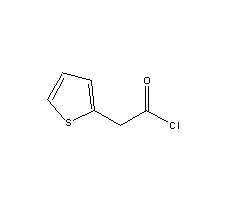FAQ
What is 2-Thiopheneacetyl chloride and what are its applications?
2-Thiopheneacetyl chloride is a
chemical compound that is commonly used in organic synthesis for the preparation of various
thioesters, amides, and other derivatives. It is a versatile reagent that can be used in the
pharmaceutical, agrochemical, and material science industries.
How is 2-Thiopheneacetyl
chloride synthesized?
2-Thiopheneacetyl chloride is synthesized by the reaction of thiophene with
acetyl chloride in the presence of a Lewis acid catalyst. This reaction typically takes place at
room temperature and results in the formation of the desired product in good yields.
What are
the key properties of 2-Thiopheneacetyl chloride?
2-Thiopheneacetyl chloride is a colorless to
pale yellow liquid with a strong odor. It is highly reactive and can undergo various chemical
transformations, making it a valuable building block for organic synthesis. It is also stable under
normal conditions and can be stored for extended periods without significant degradation.
How
is 2-Thiopheneacetyl chloride typically used in research and development?
In research and
development, 2-Thiopheneacetyl chloride is often used as a key intermediate in the synthesis of
pharmaceuticals, agrochemicals, and other specialty chemicals. It can be used to introduce the
thiopheneacetyl group into organic molecules, which can impart desired properties or functions to
the final products.
What are the safety considerations when handling 2-Thiopheneacetyl
chloride?
2-Thiopheneacetyl chloride is a reactive chemical that should be handled with care. It
is corrosive and can cause skin and eye irritation upon contact. Proper personal protective
equipment, such as gloves and goggles, should be worn when handling this compound. It should also be
used in a well-ventilated area to prevent exposure to its strong odor.


